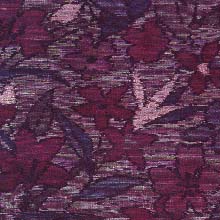Weave (p. 40 )
1. Produced in Nagai City, Yonezawa City , Nishi Okitamagun, Yamagata Prefecture.
2. Characteristics: Fabric woven with large "Kasuri" patterns. Specific threading with the threads called "Hatcho Nenshi" gives the fabric a calm color. As the quality and designs are similar to those of "Kasuri Tsumugi"(splash pattern pongee) in Ryukyu, Okinawa, it is also called "Yone Ryu", abridged from Yonezawa Ryukyu Tsumugi.
3. Uses: Kimono, Haori(coat for kimono).
4. History: As a result of the introduction of sericulture, silkworm raising "Choma" or "Karamushi" ramie, Bochmeria nipononivea, was replaced by silk. A remarkable development was made in 1751 to 1822, when the Feudal Lord Yozan Uesugi encouraged lower class warriors to work on weaving at home, inviting weaving specialists from Kyoto and Ojiya, in Niigata Prefecture and indigo dyeing specialists from Sendai, Miyagi prefecture. His effort was effective for the improvement of the Nagai Tsumugi and the market expanded to Edo(Tokyo), Kyoto and Osaka: the Tsumugi then was called "Okitama Tsumugi". At the end of the Edo Period, Tsumugi with resemblance to the one in Ryukyu(Okinawa) was produced. The "Yone Ryu" was named in early Meiji by tradesmen although it is unknown who did it. In the Meiji Period, the name was changed to "Nagai Tsumugi". As influenced by "Oshima Tsumugi" which was popular in Meiji to the Taisho Era, the color became dark brown. There are many kinds of colors today including dark blue, indigo, and white and called "Kon Gasuri" and "Shiro Gasuri".
Dyeing Method
Both warp and woof threads are dyed with plant dyes after being processed with a wood-plate tie dye method.



